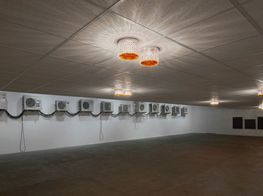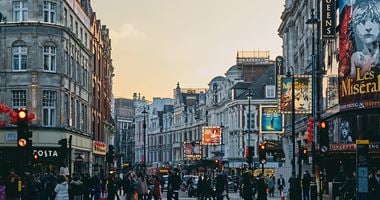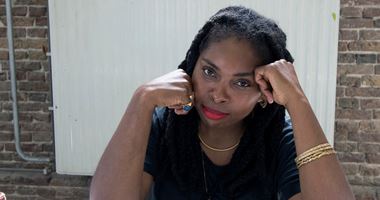Ima-Abasi Okon: ‘I’m not interested in cohesiveness at all’
Ima-Abasi Okon. Courtesy the artist. Photo: Georgia Lucas-Going.

Ima-Abasi Okon. Courtesy the artist. Photo: Georgia Lucas-Going.
Ima-Abasi Okon's current solo exhibition at East London's Chisenhale Gallery is epically titled Infinite Slippage: nonRepugnant Insolvencies T!-a!-r!-r!-y!-i!-n!-g! as Hand Claps of M's Hard'Loved'Flesh [I'M irreducibly-undone because]—Quantum Leanage-Complex-Dub (28 June–1 September 2019).
In the show, the anaemic and characterless architecture of administrative outposts—those bland centres of bureaucratic exchange—jostles with the sumptuous materials of diasporic black life.
Take, for example, the low-lying, speckled modular ceiling that is coated in morphine, insulin, ultrasound gel and gold, which has been added to half of Chisenhale Gallery's main exhibition space and incongruously adorned with pairs of bespoke glass light shades that contain a tawny mix of palm oil and high-end cognac. Or the 11 large air conditioning units installed in a line along the wall, from which a drowsy chopped and screwed remix of a sultry R&B love song emanates as the fans spin intermittently above lengths of electric cables.
Okon's practice has frequently alluded to the plenitude of black social life in often understated and oblique ways—subtly hinting at its baroque pageantries and secular rituals through accoutrements, stylised sounds, and intricate webs of references—all made to contend with the aesthetics of administered scarcity that loom over the lives of a people dispossessed.
A senior lecturer in BA Illustration and Visual Media, and a graduate of Central Saint Martins' MA design programme (2006), Okon is unsurprisingly attuned to the written word's graphic potential.
In her video work Capture Mechanism Bypass for Surplus—aChoreographic-Logic-Complex Dub (anticipatory talk back) (2018) the phrase 'By Any Means Necessary' conspicuously adorns a techno-fabric jacket by cult streetwear label Supreme, worn by a solitary figure fading into a misty vista with their back turned away in the manner of Caspar David Friedrich's Romantic masterpiece, Wanderer above the Sea of Fog (c. 1818). Supreme's 'box logo', an appropriation of Barbara Kruger's aesthetic, encloses the insurgent speech of Malcolm X, who, it has been suggested, was quoting the play Dirty Hands by Jean-Paul Sartre.
Here, Okon deftly summons layers of aesthetic history—accumulated, like a Russian doll—in a single image, whose ambiguity further propels rather than abates the inherent contradictions in conceptions of race and class, and how the two converge.
Even before an immediate encounter with Okon's work, her titling makes apparent the significance of rhythm and syntax. In the artist's own words, these are titles that 'require the viewer to do some work.' With a L=A=N=G=U=A=G=E poet's taste for concreteness and seriality, an avantgarde poetry movement that emerged in the late 1960's and early 1970s, Okon contorts linguistic constraints, exercising her signature studied indifference to the strictures of grammar in order to reveal her own idiosyncratic form of notation.
When the terms 'excess' and 'surplus' rear their heads as conceptual lodestars in her practice, they signal, beyond a Marxian inflection, bodies of work brimming with the stuff of life that more often than not slips between the cracks—things rendered negligible in the name of order and formality.
Okon participated in a group show at The Showroom, London, titled there's something in the conversation that is more interesting than the finality of (a title) (28 March–5 May 2018), for which she presented the sculptural installation ^^^^^^^^^^^^^^^^^^^^^^^^^ (2018). The title, which is also the name of an edited collection of essays released in July 2019 under Okon's publishing imprint, Press for Practice (PFP), consists of the eponymous diacritic pronounced by repeating the word 'circumflex', as if incanting a spell.
Most will run their eyes across this neat procession of signs, while the more incredulous will count the number of symbols. But the real question this title raises seems to be this: who will take the time to perform the enunciative act that verbally constitutes this name? The work itself consists of a dishwasher and pages from a 'General Service Agreement' setting out the terms under which Okon would make and supply the gallery with tablets for the machine.
Okon's delineation of work and remuneration, in her precisely worded agreement, broached the conflict of her role as a lecturer and her duty as an exhibiting artist to provide artistic labour. How we determine the value—of time, service, and care—in monetary terms, knowing full well they are incommensurable, becomes a mutual act of good faith—and one that acknowledges, as one clause states, that 'we need both to live together and to sustain ourselves.'
In this conversation, Okon reflects on her current residency at the Rijksakademie van beeldende kunsten in Amsterdam, her commitment to fragmentation as a vehicle for alternative rhythms and grammars, and her ongoing desire to resist familiar modes of circulation and consumption.
TMYou're currently on a two-year residency at the Rijksakademie van beeldende kunsten. How has it been having so much time to dedicate to your work?
IAOIt's taken me a while to get used to being on the residency and not having my time so clearly divided between a full-time job as a lecturer and trying to make work on the side. I'm still getting used to foregrounding my practice. It's a massive learning curve to be constantly coming up against yourself; there's so much time during which I'm constantly thinking about what routines I put in place—making sure that they are quite flexible so they don't become unintentionally stifling.
Above all trying not to feel guilty about having this time, and then getting into the trap of feeling like I should be producing more. Sometimes the work is about taking time, taking it slow; this is one of the main reasons why I applied for the residency. I couldn't carve out this time in London where there were so many things vying for my attention including basic existence. Producing art isn't inherently bad, but for me the stakes are quite high at the moment.
Bottom line: whom and what do I want to be in dialogue with in order to give the things that need our attention the time they deserve without depletion, co-option and certainly without the need to convince?
TMWhat are some of the things at stake for you—and how has your work been responding to these concerns lately?
IAOMy antagonism to this industry, or world rather, is not purely mercantile. Yes, I'm concerned with how a lot of institutions, in general, operate: the insincerity of gestures, nepotism, unfairness, self-congratulatory behaviour and more.
Yes, I get joy from making work but how do I practice without perpetuating the system's violence? I mean let's be very clear here, some of the cogs that grease this beast are in direct opposition to not only my existence but to the earth's, not as a project but as a truth.
You don't have to look very far for that evidence, and I am grateful for the people doing the work that brings this to light, since it allows me to have certain conversations, and very necessary ones, with myself.
Forget the work, but what am I aligning myself with and how do I keep that commitment, so that it shows up in every sphere of my life and the lives of those I encounter? This is happening in real time.
For me, this is very much the work, what then takes place in an exhibition context is a fall-out from that. I'm working through abstractions—as a way to speak to a very particular audience and reading things. But creating strategies out of and beyond them is the goal.
Real life strategies or, to borrow a term from Maria Lugones, 'tactical-strategies' that can be that can be applied (and yielded) to (and from) the everyday. Being a lecturer has also in some regard allowed me to operate slowly to produce the work that I want to be producing or at least am attempting to produce.
The holding space programme, a year-long programme of research that culminated in an exhibition at The Showroom in London, helped identify a number of methodologies that I wanted to apply post the programme.
Being in dialogue with artists Onyeka Igwe, Jade Montserrat, Raju Rage, Adam Farah, Jamila Johnson Small, Daniella Valz Gen, and Alberta Whittle and curatorial fellow Teresa Cisneros has and continues to be an integral experience. It's really about changing my priorities or rather actually acknowledging that they weren't what I thought they were.
I was dealing with some things that have a way of cutting through stuff without your permission. You have no choice but to sit back and say 'huh, ok!'. Letting those things unfold and seeing what comes from that is something I now want to enact with a level of intentionality. Going through it wasn't the most pleasant thing, but now that I have some distance I think it's a great litmus test to apply to so many other things happening around me.
Bottom line: whom and what do I want to be in dialogue with in order to give the things that need our attention the time they deserve without depletion, co-option and certainly without the need to convince?
The objective is to resist ownership; to resist categorisation.
TMYou have a longstanding interest in how knowledge is produced, shared, or withheld—and how certain forms of vernacular expression are suppressed or distorted.
IAOI'm interested in fragmentation as a way of producing knowledge. The objective is to resist ownership; to resist categorisation. Fragmenting as a tactical strategy thwarts the ready-to-perform-understanding that sets about to achieve cohesion. I'm not interested in cohesiveness at all—a 'cohesiveness' that finds a comparable trait in its cousin 'categorisation'—neither as an idea nor where it comes from.
I think it's a fall-out from the violent structures of modernism. Knowledge, certainly in education, has been posited as this thing that you own, that sits with certain people who you have to approach to gain it.
I have no time for that type of model and so I constantly try to fragment things so they can't be owned or attained in conventional ways. If I fragment something it's difficult to see the back from the front—you have to work for it and you have to work hard. It also yields a type of plural-potentiality that, in my opinion, opens it up to be so much more. Almost prophetic.
One of the reasons why I think I am suited for 1st year students is that I am always asking for more; what else does this—does the students' work—speak to. Personally, I'm always trying to think of how I can show where I'm coming from. And it's not from one easily definable place.
TMA special kind of fragmenting happens in 'chopped and screwed' music to create its dramatically reduced pitch, distorted lyrics, and drowsy sound—like the remix of 'Adorn' by Miguel playing from the 11 industrial air conditioners in your exhibition at Chisenhale Gallery. You've referred to this Southern hip-hop subculture in previous work titles as well. What is it that's drawn you to it?
IAOBecause it's so slow and so textured, it slows things right down—all the way down. It's almost a litmus test that asks: 'Can you hang? Are you willing to wait for this?'
I want to convert making and experiencing art into something of a slow-burn diet. We have a culture of having things delivered instantly but when you slow things down there are perspectives that come to the fore—perspectives you never even knew existed or were present. Different notes start to come through.
Besides that, I was really taken aback by the intentionality of lean, the drink and the music. It's spatial in so many ways. It has a profound interiority and a exteriority that is atmospheric and full of agency.
It's a praxis of sustained (un)(dis)engagement. I've been asked about my interest in this before, and actually I realise now that I don't want over-describe or explain. It's operating and existing, which is enough.
I'm interested in, including taking hold of language and bending it to suit the writer and how they're approaching it.
TMThere's a distinct lack of character to the architecture of waiting rooms and sites of 'processing' that you've made use of in your current show.
The low-lying modular ceiling, air conditioning units, and lengths of black cables evoke the impersonal feeling of these spaces and their transactions, which is at odds with the craftsmanship of the hand-blown glass light shades and the translucent glow of the Courvoisier VS cognac and palm oil mix inside them. What kind of tension were you looking to create by placing these things together?
IAOIncongruous, contradictory, incompatible, incoherent, inappropriate.
On my wall in the studio, I have made a diagram, which primarily charts an ongoing game of word association. On the top it reads 'EXCESS vs RESTRAINT'. Underneath is a list of words that go on to describe instances of each, as they exist in the everyday. Underneath that is a list of materials that have these attributes as a trait. It can be read as an analogy for so many things. It's where I start and often return.
TMIn 'Theory of the Minor' (2017)—an essay that is more modest and less of a stately disquisition than the title suggests—Chris Sharp champions idiosyncrasy and all the thorny little particularities that prevent certain practices from being instrumentalised, or assimilated into a crudely politicised programme or movement of some kind.
IAOThe wonderful person and artist that is free.yard sent me that text. I love them. Circling back to your question regarding what's at stake, one thing for sure is actually finding the time to build meaningful relationships with certain individuals who also, in my opinion, have a grasp of where and what the work is.
Sharp's text resonated enormously with some of the conversations that free.yard and I have had and stuff that I have been marinating in. I quite like what Sharp does with language in that piece. He's pushing you to change what you understand as the definition of the term 'minor'—from the classical, art historical, sense to the Deleuzian use of the word.
In terms of hierarchy we understand minor as being 'less than' but he's flipped our understanding on its head to highlight the richness and the excess within the minor, and a probable intentionality of being a minor. Adopting that as a position, which is generative, does a lot of things that I'm interested in, including taking hold of language and bending it to suit the writer and how they're approaching it.
So, there's already a dissonance with our presumptions; you can't just approach the piece any odd way. Sharp is changing meaning in ways that you have to reorient yourself to, before you can begin to understand his project.
The conventions of grammar aren't always useful for me. So how do I privilege my default way of speaking or being?
I've used this example before about cacti and succulents. Succulents are a must have in some form when curating your 'urban jungle'. All cacti are succulents, but not all succulents are cacti. And 'we' need to be more like the cacti whereby in their very DNA they have a mechanism that forces people to navigate them in a particular way—like, don't just pull up and think you can hold this as you will get pricked. Also, the areoles on cacti bring about both flowers and spines.
Now situating myself in an art context and thinking about Sharp's text, this is a strategy I am trying to realise. How do I withhold from—and be antagonistic to—some while being generous to those I want to be generous to at the same time in a structure that wants to instrumentalise? How do you do that?
Throw a legislation of care at it? Obsfucate? And how do you embed this in the actual work itself? Materially? What materials have this as their property? Again, it's something I am working through and have attempted to do so in the past.
A lot of my resistance comes from my experience teaching in a university. This is the thing that drives me crazy: a policy is basically someone saying 'this is how it worked for me so I'm going to say how things should work for others'. That's how taste works—and taste in graphic design is problematic.
How typography looks influences language—so if we're not actually looking at type and say, for example, the way and the conditions under which fonts are designed, language will be allowed to get away with these hideous things. It's in typography that semantics and grammar sit; it's the architecture in which language is housed and how it is transmitted.
So here's a system that is already antagonistic to someone with a so-called learning disability—someone who has to re-orient themselves because a dominant structure sees them as an aberration whose experience is not worthy of reflecting or accommodating.
The conventions of grammar aren't always useful for me. So how do I privilege my default way of speaking or being? What if I could read a book or an article that indicated where the emphasis of someone's speech was, and how they pronounced words or stuttered and paused? I'm interested in a form of punctuation that really en-fleshes the written word.
In a way with these video works, it was an exercise in mapping excess onto shooting video.
TMThe written word shows up in your moving image work Capture Mechanism Bypass for Surplus—aChoreographic-Logic-Complex Dub (anticipatory talk back) on a jacket by cult streetwear label Supreme, whose 'box logo' was lifted from the work of Barbara Kruger. The central figure's position calls to mind the Rückenfigur in Caspar David Friedrich's Wanderer above the Sea of Fog (c. 1818).
In what ways do you see the moving image, as a medium, extending or contributing to how your work is presented and how it circulates?
IAOThere are a few works that operate as a series. One of them is a collection of sneaker reviews. They are conducted by my brother, who's a reseller, in my studio on the occasion of every new pair I buy. My need—or desire, rather—for a pair of sneakers, and my brother's willingness, dictate when a new video will be made and how long the series will last.
Circling back to your earlier question about knowledge, this was another area that I felt was producing and theorising outside usual systems. It's not completely dismissive of a capitalist structure, but there is an element or circumvention that happens, and a vocabulary that is then generated by it, to organise itself and its participants.
Capture Mechanism Bypass for Surplus—aChoreographic-Logic-Complex Dub (anticipatory talk back) was a fall-out from these videos. I had previously seen the jacket advertised and then saw that he had bought a few. This spurred a few discussions about appropriation, taste, and so on.
From there I just kept on thinking about this triangulation between Supreme, and what we know about them, The Northface, and what we know about them, and a motto about struggle—a very much unresolved one. I couldn't reconcile it. Using video allowed me to capture these things in real time, as well as continue my exploration into translating all the things we've spoken about into an aesthetic.
I am referring to technicality. To do away with a skill-set or set requirements that make a successful video. For instance, having the lens in focus. The gain on the sound adjusted. A sturdy stabiliser. Unnecessary use of the zoom, et cetera. All of these were under or over exposed or utilised on a whim. Not only did this free me up from worrying about working with video and not being fully proficient; in my head it was also a very technical challenge.
In a way with these video works, it was an exercise in mapping excess onto shooting video. If we think about all the synonyms of excess, how can I be wasteful, reckless, extravagant, uncontrolled, exorbitant with the camera settings, the way I hold it and only utilising one take.
With regard to fragmenting knowledge, the medium allowed me to explore this in a very hands on way. There came a point when I knew what the action would be—the technical mapping and what it produced visually became the actual content. However, I have to rethink my relationship to it as, for the time being, I don't want the work to feature a figure. I am making moves to abandon it. —[O]



![Exhibition view: Ima-Abasi Okon, Infinite Slippage: nonRepugnant Insolvencies T!-a!-r!-r!-y!-i!-n!-g! as Hand Claps of M's Hard'Loved'Flesh [I'M irreducibly-undone because]—Quantum Leanage-Complex-Dub, Chisenhale Gallery, London (28 June–1 September 2019). Commissioned and produced by Chisenhale Gallery.](https://files.ocula.com/anzax/Content/Conversations%2FIma-Abasi%20Okon%2FImaAbasiOkonChisenhaleGallery1_400_0.jpg)



![Ima-Abasi Okon, Mahalia's CounterApparatus: A profound Intimacy of inter—locking detail—I want it Alot More M-o-i-s-t, Wett'er, What! What! Yes!(Redmahogany&Mahogany&Kolonial&Walnut) (2019). Exhibition view: Infinite Slippage: nonRepugnant Insolvencies T!-a!-r!-r!-y!-i!-n!-g! as Hand Claps of M's Hard'Loved'Flesh [I'M irreducibly-undone because]—Quantum Leanage-Complex-Dub, Chisenhale Gallery, London (28 June–1 September 2019). Commissioned and produced by Chisenhale Gallery.](https://files.ocula.com/anzax/Content/Conversations%2FIma-Abasi%20Okon%2FImaAbasiOkonChisenhaleGallery2_400_0.jpg)

![Exhibition view: Ima-Abasi Okon, Infinite Slippage: nonRepugnant Insolvencies T!-a!-r!-r!-y!-i!-n!-g! as Hand Claps of M's Hard'Loved'Flesh [I'M irreducibly-undone because]—Quantum Leanage-Complex-Dub, Chisenhale Gallery, London (28 June–1 September 2019). Commissioned and produced by Chisenhale Gallery.](https://files.ocula.com/anzax/Content/Conversations%2FIma-Abasi%20Okon%2FImaAbasiOkonChisenhaleGallery3_400_0.jpg)

![Ima-Abasi Okon, When the —[After-the-world presocial vivid therenessssssss and ongoinglyyyy] — is in the system (2019). Exhibition view: Infinite Slippage: nonRepugnant Insolvencies T!-a!-r!-r!-y!-i!-n!-g! as Hand Claps of M's Hard'Loved'Flesh [I'M irreducibly-undone because]—Quantum Leanage-Complex-Dub, Chisenhale Gallery, London (28 June–1 September 2019). Commissioned and produced by Chisenhale Gallery.](https://files.ocula.com/anzax/Content/Conversations%2FIma-Abasi%20Okon%2FImaAbasiOkonChisenhaleGallery4_400_0.jpg)
![Ima-Abasi Okon, When the —[After-the-world presocial vivid therenessssssssssss and ongoinglyyyyyy] — is in the system (2019). Exhibition view: Infinite Slippage: nonRepugnant Insolvencies T!-a!-r!-r!-y!-i!-n!-g! as Hand Claps of M’s Hard’Loved’Flesh [I’M irreducibly-undone because]—Quantum Leanage-Complex-Dub, Chisenhale Gallery, London (28 June – 1 September 2019). Commissioned and produced by Chisenhale Gallery. Courtesy the artist. Photo: Andy Keate.](https://files.ocula.com/anzax/Content/Conversations%2FIma-Abasi%20Okon%2F05ImaAbasiOkonatChisenhaleGalleryPhotoAndyKeate_400_0.jpg)
![Exhibition view: Ima-Abasi Okon, Infinite Slippage: nonRepugnant Insolvencies T!-a!-r!-r!-y!-i!-n!-g! as Hand Claps of M's Hard'Loved'Flesh [I'M irreducibly-undone because]—Quantum Leanage-Complex-Dub, Chisenhale Gallery, London (28 June–1 September 2019). Commissioned and produced by Chisenhale Gallery.](https://files.ocula.com/anzax/Content/Conversations%2FIma-Abasi%20Okon%2F06ImaAbasiOkonatChisenhaleGalleryPhotoAndyKeatecopy1440x1080_400_0.jpg)








































































































































































